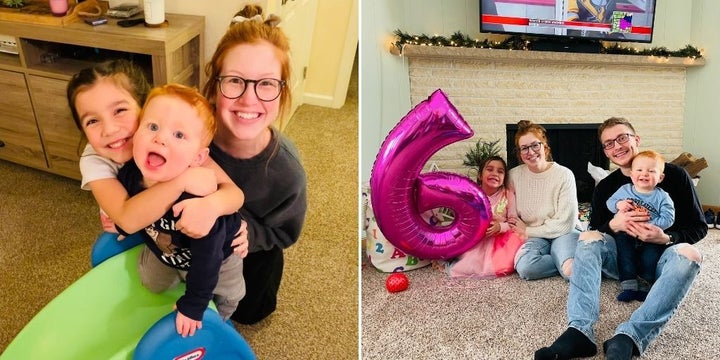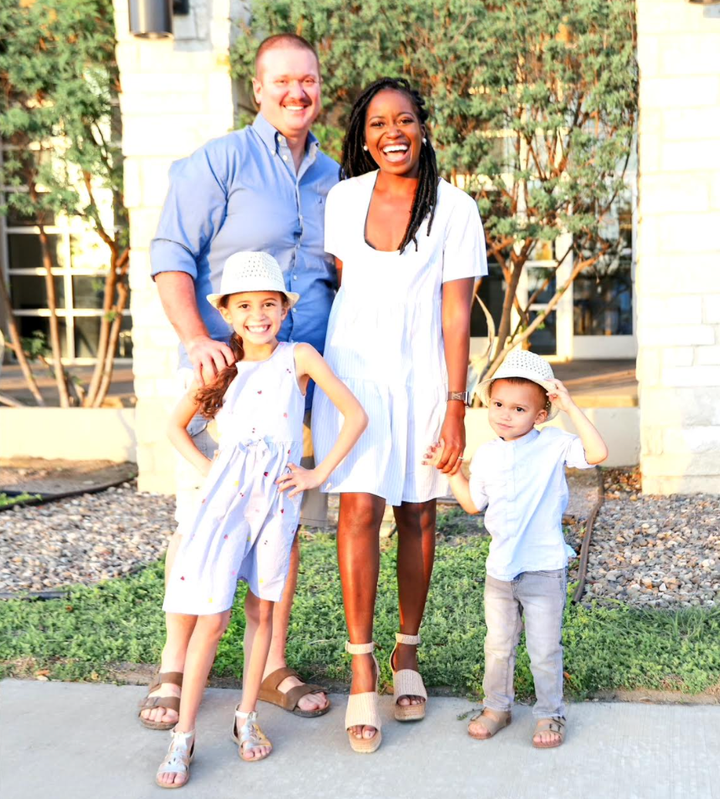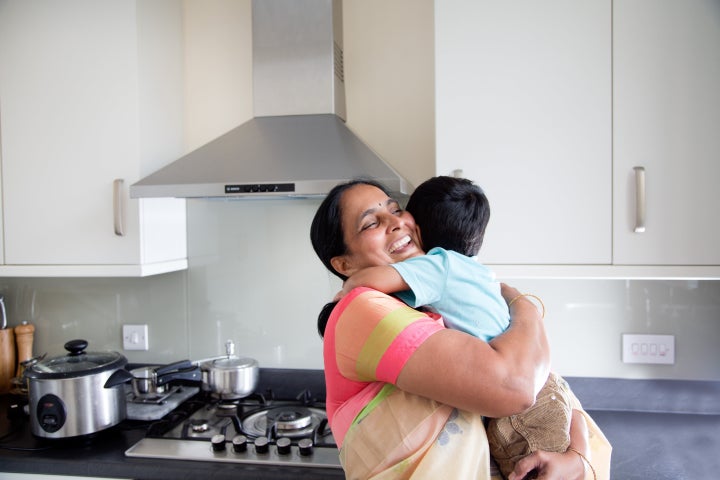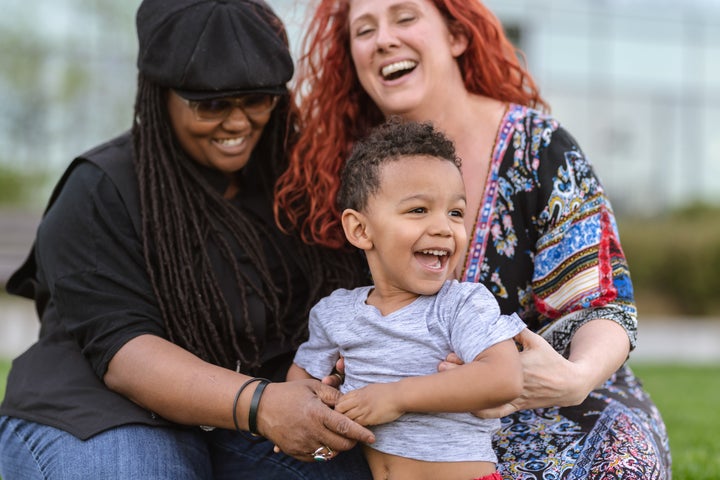At Holly Matuszak’s home in Toledo, Ohio, the Pixar movie “Coco” is in heavy rotation.
It’s no surprise, given that Matuszak has a 6-year-old daughter and a 1-year-old son.
But the animated movie, which celebrates Mexican culture and history, holds special significance for the family: Matuszak’s daughter is mixed: Her father is Mexican and her mother’s background is white European. She loves the movie now, but that wasn’t always the case.
“When she was 3, she cried about seeing ‘Coco’ and not wanting to be Mexican,” Matuszak, a registered nurse case manager, told HuffPost.
“Her dad and I both explained, in toddler terms, how special it is to have different pieces that make you whole and how cool it is to have parents who grew up in different countries,” she said.
Matuszak and her now-ex did and still do everything possible to immerse their daughter in both cultures equally, so her “white side is not the only thing she experiences each day” ― Spanish lessons, trips to the local panadería with her dad. Still, as the “Coco” issue shows, that can be a battle.
When you’re a mixed-race kid who looks “different,” you’re bound to dwell on it. Those differences are heightened for Matuszak’s daughter since her brother has a different dad and is “very fair-skinned” with bright red hair and blue eyes.
“My daughter has beautiful tan skin with gorgeous, thick brown hair and brown eyes, so she does look Mexican, but the rest of our family has fair skin ― many of us even have red hair,” she said.
It hasn’t gone unnoticed by her daughter.
“She recently made the comment that she wanted to be ‘bright’ like me,” Matuszak said. “I think this stems from looking different than the rest of our side of the family and being an age where she’s starting to recognize this.”
Matuszak’s experiences with aren’t uncommon. In a society that elevates white European culture and at least up until recently has relentlessly stressed assimilation, many multiracial children grapple with their perceived “otherness.”
Sometimes, that plays out in internalized racism. For many multiracial people growing up, there’s a feeling of needing to “choose one of their sides” over the other, either consciously or unconsciously, said Kevin Nadal, a professor of psychology at City University of New York and author of “Microaggressions and Traumatic Stress.”
“It can happen as a result of people telling them that they’re not Asian/Black/Latino enough, people making fun of one part of their heritage either directly or maliciously; or even people who disparage one of their identities unknowingly because they don’t know of their other heritage or multiracial identity,” Nadal told HuffPost.
As a kid, it’s a whole lot easier to just blend in as monoracial to fit in with whoever the majority of their peers are.
That said, it’s also very common for multiracial kids to develop a healthy and strong multiracial identity. For that to happen, Nadal said their parents and families need to provide them with “a strong sense of self and teach them to love all of their heritages.”
Matuszak and her co-parent are doing just that. At age 6, her daughter absolutely loves “Coco” and so much more that celebrates her Mexican heritage.
“We make sure she gets to hear personal stories from her dad about his life and experiences,” she said. “He speaks Spanish to her, and she loves it. She watches ‘Elena of Avalor’ on TV. She is starting to understand that we all have different skin, but that is what makes everyone so unique and special.”

How else can you foster a positive sense of cultural identity if your kids are mixed race? Below, parents like Matuszak and experts including Nadal share six helpful tips.
Talk about race early and often.
Chris C. Wise, a Texas-based lifestyle blogger, has two kids, a 7-year-old daughter and a son who’s almost 3. Wise is Liberian, and her husband is German. Together, they’re hyper-conscious that one day their kids might feel the cultural expectation to “pick a side,” and that worries them.
“That idea is so disrespectful and confusing to biracial kids,” Wise told HuffPost. “Or the idea that they’re ‘too white’ or ‘too Black.’”
To counter what the kids are likely to experience, Wise and her husband broach a lot of age-appropriate conversations about race and what it means to be Black and white in America. (The family is religious, so they often base these conversations in that context.)
“Parents are the first dose of education that children will get in their life,” she said. “I think it’s important to educate them on the importance of knowing both sides, embracing both sides and instilling in them that they are fearfully and wonderfully made in the image of God.”

Get both sides of your family involved in educating.
Wise and her husband bring their families into these culture-rich conversations, too.
“Their grandparents and older aunts on both sides do their part in educating them on cultures, traditions and things of the past, since some lived to see things that us millennial parents didn’t,” she said. “The values, traditions and the things experienced from my mom growing up in Liberia, I couldn’t explain in depth to my kids because I wasn’t there. But mom can and does to all of her grandchildren, and they cherish that so much.”
Jacqueline Douge, a pediatrician and author of the young adult book “Learning to Love All of Me,” recommends taking it a step further: Give your kids the opportunity to “interview” family members or learn how to make a special cultural recipe. (Even better if both sides of your family are able to participate at once.)
“This gives kids a great opportunity to ask any questions they may have about their identities,” she said.

Surround them with media that features characters that look like them.
Luckily, you don’t have to do all the teaching. These days, picture books and young adult fiction feature characters of a veritable rainbow of ethnicities and backgrounds. TV and movies are getting better, too. Lean on these books early and often, Douge said.
“Parents and children can learn together about their child’s heritages through books that feature characters that represent their cultures, languages and varied experiences,” she said.
Give them the language to use when someone asks, “What are you”?
Stacy-Ann Gooden, a meteorologist in New York City, and her husband are the parents of a 10-year-old daughter and 7-year-old son. The kids are of Irish, German, African and Caribbean descent.
Gooden and her husband talk to them openly about what it means to be multiracial, the conversations about police brutality they see in the news and how to respond to everyday racism. (An encounter in a store a few years back all but forced the racism conversation. Gooden and her daughter were at a craft store in a predominantly white neighborhood and found money someone had dropped. When Gooden tried to report the lost cash to a store manager, she was accused of stealing. Her daughter witnessed it all.)
The couple also give their kids the language to talk about their multiracial background so if anyone at school or elsewhere asks “What are you?” they know how to respond.
“Unfortunately, there are some who inappropriately ask that question,” Gooden said. “When that happens, their responses are always ‘I am human.’ While some may consider them Black, we teach them to embrace being both Black and white.”

If they talk about feeling the need to “pick a side” or be seen as white, help them understand why that is.
When kids notice an obvious difference in themselves ― for instance, the
the color of their skin or the language they speak ― many will gravitate to the
side that seems more dominant in their environment, just to avoid being labeled as different.
At a young age, they can’t comprehend that themselves, so help them understand, said Azaria Davis, a clinical social worker who’s Black and Jewish.
“Children are often unable to verbalize what they feel, so taking the time to validate their feelings and experiences can provide them with the words to express them,” she said.
If you think racism or experiencing a racial microaggression might be one of the reasons they’re distancing themselves from one side, don’t let them grapple with those difficult feelings alone.
“First and foremost, it’s important to be honest with your child,” Davis said. “If we pretend that racism and white supremacy don’t exist, especially when
children bring it up, it can teach them to second guess what they are
observing and internalizing about how people interact.”
Immerse them in lived experiences that celebrate their cultures, not just books and movies that are heavy on positive representation.
Matuszak doesn’t just put on a movie that’s big on representation and call it a day. She and her ex go out of their way to make sure their daughter’s Mexican heritage is a part of her everyday life. It helps, too, that she’s surrounded by a diverse community.
“She has friends of all backgrounds in her class, which is so important because diversity is a wonderful thing,” Matuszak said. “She is starting to see how beautiful it is for everyone to be so different, and she is really starting to fall in love with her Mexican side because she sees how special it makes her instead of inferior.”
Today, the 6-year-old “loves both parts of her equally,” her mom said, and is finally grasping that both sides are important.
Case in point: The family just got a new white dog. Her name? Leche, the Spanish word for “milk.”
This article is auto-generated by Algorithm Source: www.huffpost.com


